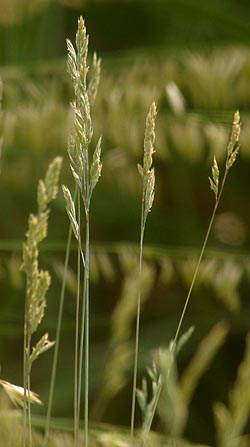Sheep Fescue

Common Name(s):
Sheep Fescue
Blue Fescue
Scientific Name:
Festuca ovina L.
Scientific Name Synonyms:
None known
Symbol:
FEOV
Description:
Life Span: Perennial
Origin: Native
Season: Cool
Growth Characteristics: Sheep fescue is a densely tufted perennial which grows to heights of up to 40 inches and reproduces primarily by seed but also spreads vegetatively through tillering. Growth occurs from June to September. Roots are numerous, fibrous and fine.
Seedhead: A narrow, tightly compressed and spikelike panicle 2-4 inches long. Spikelets have 3-7 florets which are up to ¼ inch long. The glumes are arrow shaped and unequal. The first glume is 1-veined and 1/16-1/8 inches long; the second glume is 3-nerved and 1/8-1/4 inches long. The lemmas are awned at the tip and 1/8 long.
Leaves: Mainly basal, numerous, and rolled. They are very slender, rough to the touch on the margins, and 2-5 inches long. They are less than half the length of the stem, the stem leaves are few and very short. The sheaths are open, auricles are absent, and the ligule is membranous. The leaves are blue-green-gray in color which helps identify this species from other similar grasses.
Stems: Erect stems, 6-24 inches tall (average is less than 14 inches tall).
Ecological Adaptions:
This species is found at elevations from 5000-8000 feet on mesic open hillsides, meadows, or open woodlands. It requires 16-22 inches of precipitation. This species has many forms influenced by habitat.
Soils: Often found in dry, well-drained, sandy, gravelly, or rocky soils, but also found in moister clayey soils.
Associated Species: Rabbitbrush, sagebrush, asters, geraniums, serviceberry, mountain brome and Letterman needlegrass.
Uses and Management:
Sheep fescue is a valuable forage grass for all livestock. It starts growth early in the spring and tends to remain green late into the season. Sheep fescue is resistant to drought and heavy frost, but does not tolerate heavy grazing pressure. Sheep fescue is circumboreal, that is, native to boreal regions of the northern hemisphere. Commercial varieties developed from European forms are use in lawn seed mixes, for erosion control, or as ornamentals (Festuca ovina var. glauca).

